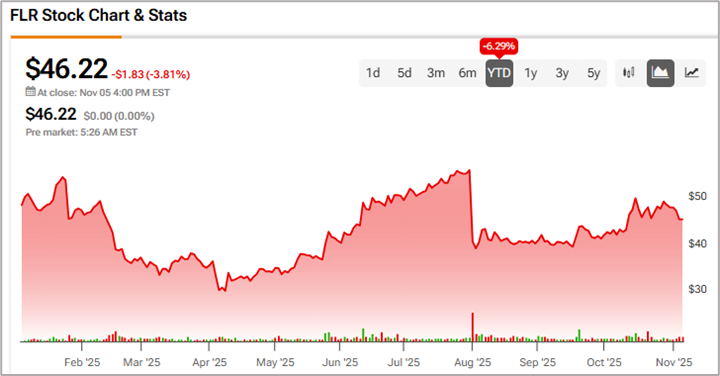A class action lawsuit was filed against Fluor Corp. (FLR) on September 15, 2025. The plaintiffs (shareholders) alleged that they bought Fluor stock at artificially inflated prices between February 18, 2025, and July 31, 2025 (Class Period) and are now seeking compensation for their financial losses. Investors who bought Fluor stock during that period can click here to learn about joining the lawsuit.
Claim 70% Off TipRanks This Holiday Season
- Unlock hedge fund-level data and powerful investing tools for smarter, sharper decisions
- Stay ahead of the market with the latest news and analysis and maximize your portfolio's potential
Fluor is a global engineering, procurement, construction (EPC), and maintenance company providing professional and technical services across various industries. Among other things, the Company’s infrastructure projects include work on the Gordie Howe International Bridge (Gordie Howe), as well as the Interstate 365 (I-635/LBJ) and Interstate 35E, and I-35 highways in Texas.
The company’s claims about the costs of its infrastructure projects and the declining demand for its services are at the heart of the current complaint.
Fluor’s Misleading Claims
According to the lawsuit, Fluor and four of its current and/or former senior officers and/or directors (the Defendants) repeatedly made false and misleading public statements throughout the Class Period. In particular, they are accused of omitting truthful information about the reasons for increasing costs associated with the Gordie Howe, I-635/LBJ, and I-35 projects and ancillary issues, from SEC filings and related material.
In an annual report filed at the beginning of the Class Period, Fluor noted that its experienced team uses a careful, organized system to find and manage risks, which it believes helps reduce costs and meet client deadlines.
In the same report, the company said its business can vary throughout the year due to factors like weather, customer spending habits, bidding periods, regulatory approvals, project schedules, and holidays.
Finally, during a May 2, 2025 call with analysts and investors, the company’s CEO said that Fluor’s strategy and supply chain expertise put it in a strong position to handle projects both in the U.S. and abroad. He added that clients are moving forward quickly with projects that need to reach the market fast and are not slowing down.
However, subsequent events (detailed below) revealed that the defendants had failed to inform investors that customers had cut capital spending and that clients were delaying decisions due to economic uncertainty.
Plaintiffs’ Arguments
The plaintiffs maintain that the defendants deceived investors by lying and withholding critical information about the company’s business practices and prospects during the Class Period. Importantly, the defendants allegedly misled investors regarding the negative impacts on Fluor’s business and financial performance.
The information became clear on August 1, 2025, when Fluor released disappointing results for the second quarter of fiscal 2025. The company reported earnings of $0.43 per share, which was $0.13 below expectations, and revenue of $3.98 billion, down 5.9% from the previous year and $570 million below forecasts.
Fluor attributed the weak results to rising costs on several infrastructure projects caused by subcontractor design mistakes, price increases, scheduling delays, and lower customer spending.
Fluor also lowered its 2025 financial forecast, projecting adjusted EBITDA of $475 million to $525 million and adjusted earnings of $1.95 per share to $2.15 per share. The company said the downgrade was due to client hesitation caused by economic uncertainty, which affected new project awards, delays, and quarterly results. Following the results, FLR stock plunged 27%.
To conclude, the defendants failed to inform investors that continued weakness in customer spending and rising project costs were expected to affect the company’s financial results. Due to these issues, FLR stock has lost 6.3% year-to-date.

















